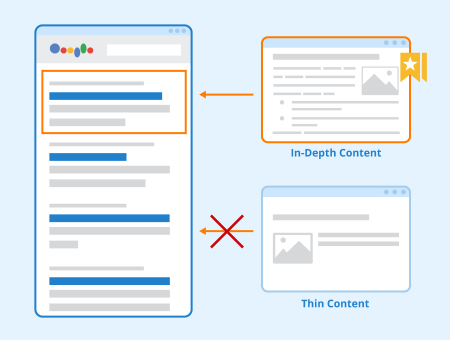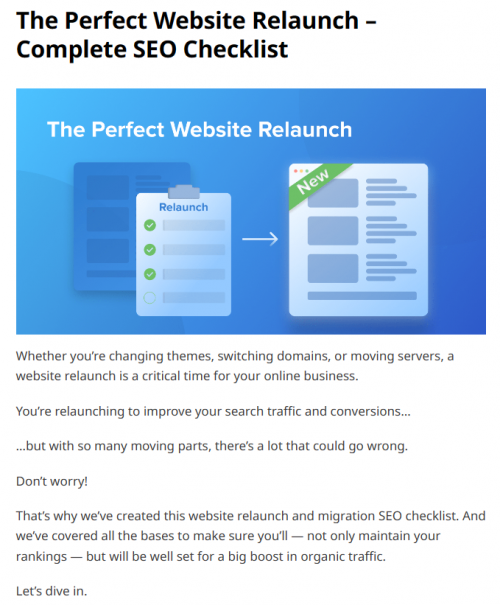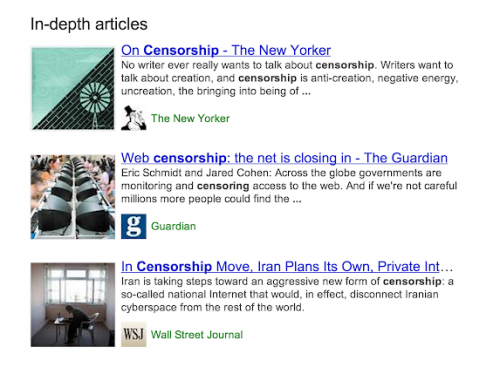What are in-depth articles?

In-depth articles are articles that go into great detail on a topic, covering everything that might be useful to a reader. In-depth articles offer an improved user experience when ranking for informational-intent keywords as they provide all the information that a searcher is looking for.
Although in-depth articles cover a topic in its entirety, this doesn’t always mean the articles have to be extremely long. If an entire topic can be covered in a few paragraphs, then it is still classed as in-depth content.
Key attributes of in-depth articles
- Comprehensive coverage: Ensures all aspects, angles, and nuances of the topic are explored and explained.
- Detail-oriented: Goes beyond surface-level information by providing specific details, examples, and data.
- Well-researched: Demonstrates a high level of research, often involving multiple, credible sources and data points.
- Logical structure: Often follows a structured format that guides the reader through a logical progression of the topic.
- Visual elements: May include various forms of visual content like charts, graphs, and images to support and enhance the detailed information.
- Credibility: Typically involves providing citations, references, and attributions to uphold the reliability and accuracy of the information.
- Updated: In-depth articles are often updated to ensure all the comprehensive information remains current and applicable.
Below is an image of an in-depth blog post on the Seobility blog, which displays all of the key attributes mentioned.

An example of an in-depth blog post on Website Relaunches
The importance of in-depth articles
Writing in-depth articles is important for improving the user experience of a website. It also helps articles rank for related keywords, as long-tail keywords and keyword variations are naturally added to the article as it is written.
Benefits of in-depth articles can include:
- Improved user signals – By satisfying the user intent and providing them with all the information they may need, user signals on your website should improve.
- Ranking for more long-tail keywords – By naturally including all important aspects of a topic, it’s easier to rank for long-tail keywords.
- Improved rankings – Highly relevant content that provides searchers with the information they’re looking for ranks easier than thin content pages.
- Clear topical relevance – By covering a topic in its entirety, the page has clear relevance to the topic.
- More backlinks – High-quality in-depth articles are valuable resources that people want to link to, making it easier to build backlinks to the page.
Challenges of writing/producing in-depth articles
Crafting in-depth articles, while beneficial, also comes with its own set of challenges that marketing teams have to navigate through. Some of these include:
- Time and resource-intensive: Developing in-depth content demands extensive research, fact-checking, and sometimes, expert interviews, which can be time-consuming and resource-intensive.
- Maintaining reader engagement: Striking a balance between providing comprehensive information and maintaining an engaging writing style to keep the reader’s attention throughout a lengthy piece can be challenging.
- SEO optimization: Ensuring that the article is not only rich in information but also optimized for search engines without compromising readability and user experience poses a challenge.
- Visual content creation: Developing relevant and informative visual content like charts, graphs, and infographics that align with the detailed information can be labor-intensive for longer, in-depth articles.
- Content updates: Keeping the article updated with the most recent and relevant information, data, and research requires continuous effort and monitoring.
- Avoiding redundancy: Ensuring that the content is not repetitive and each section brings new, valuable insights to the reader is crucial.
In the past
In the past, thin content was able to rank well in the SERPs. In the late nineties and early 2000s, search engines had very simple algorithms that were easy to manipulate.
This led many SEOs and webmasters to create a large quantity of thin-content pages, and subsequently forcing them to the top of the SERPs through link building and keyword stuffing.
As search engine algorithms got more complex, thin content became less effective and can now even result in ranking losses. This shifted the focus from thin content to in-depth content, improving the search experience of users.
Google’s in-depth article search feature
In 2013, Google introduced a search feature called in-depth articles in which in-depth articles were highlighted in the SERPs much like the Google News OneBox today.

Image of the old In-depth articles feature on Google Inside Search
This search feature mainly appeared on broad keywords where the search intent wasn’t clear, like when searching for names, places, objects, or other general terms.
By providing a search feature highlighting in-depth content on the topic, it made it easier for people to find the content they were looking for.
This feature has been discontinued, but when people refer to “Google in-depth articles” they are generally referring to the search feature as opposed to the general meaning of the term.
Its relevance to SEO
In-depth content generally outperforms thin content, especially when competing for informational-intent keywords. SEO benefits can include an easier time building links, improved user signals, and ranking for more long-tail search terms, among others.
Google’s Panda Update back in 2011 can be seen as the starting point of their focus on high-quality, in-depth content. The Panda Update aimed to demote thin, low-quality content and focused mainly on things like keyword stuffing, plagiarised content and general webspam. Hummingbird, which was rolled out in 2013, Rankbrain (2015), Medic (2018) and Bert (2019) all placed at least some focus on content quality and depth as well, covering things like webspam and shallow content, but also topical relevance and E-A-T.
In recent years, Google has continued this trend, with various algorithm updates targeting low-quality web pages. This includes multiple Helpful Content Updates and Product Review Updates, making it more important than ever to create helpful, in-depth content on your website.
In-depth articles on your blog can also have various other content marketing benefits. For example, it can be repurposed for use on social media channels or web 2.0 blogs for increased exposure, as well as providing value to your audience when promoted on other channels.
All-in-all, creating in-depth content is more important than ever before for both SEO and general marketing purposes.
Related links
- https://searchengineland.com/whats-going-on-with-in-depth-articles-on-google-313863
- https://copyblogger.com/in-depth-article-ranking/
- https://developers.google.com/search/docs/fundamentals/creating-helpful-content
Similar articles
